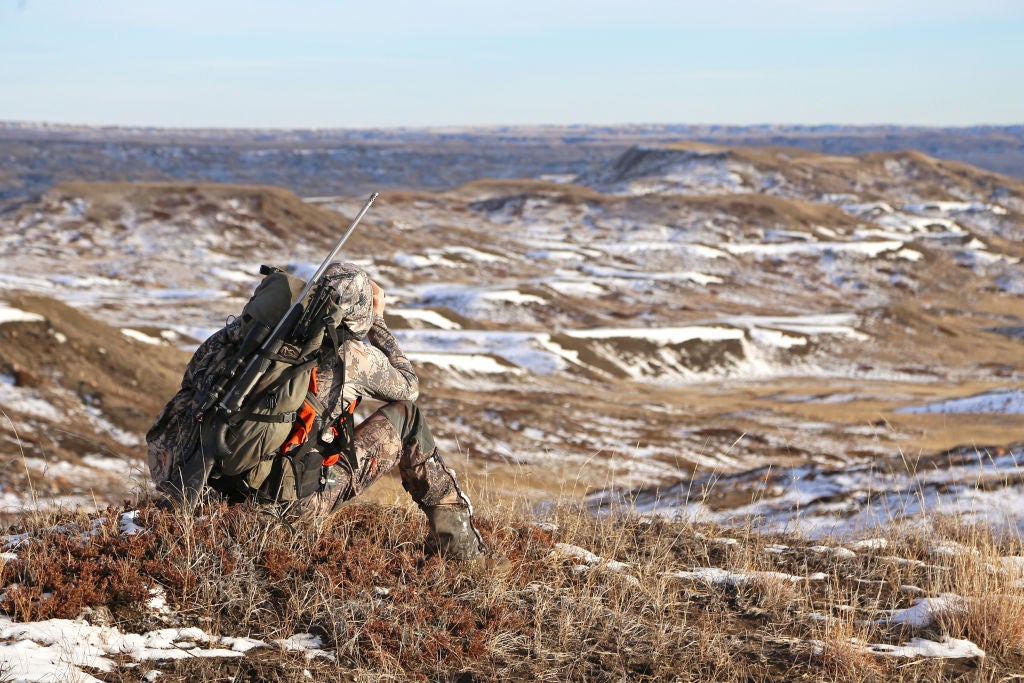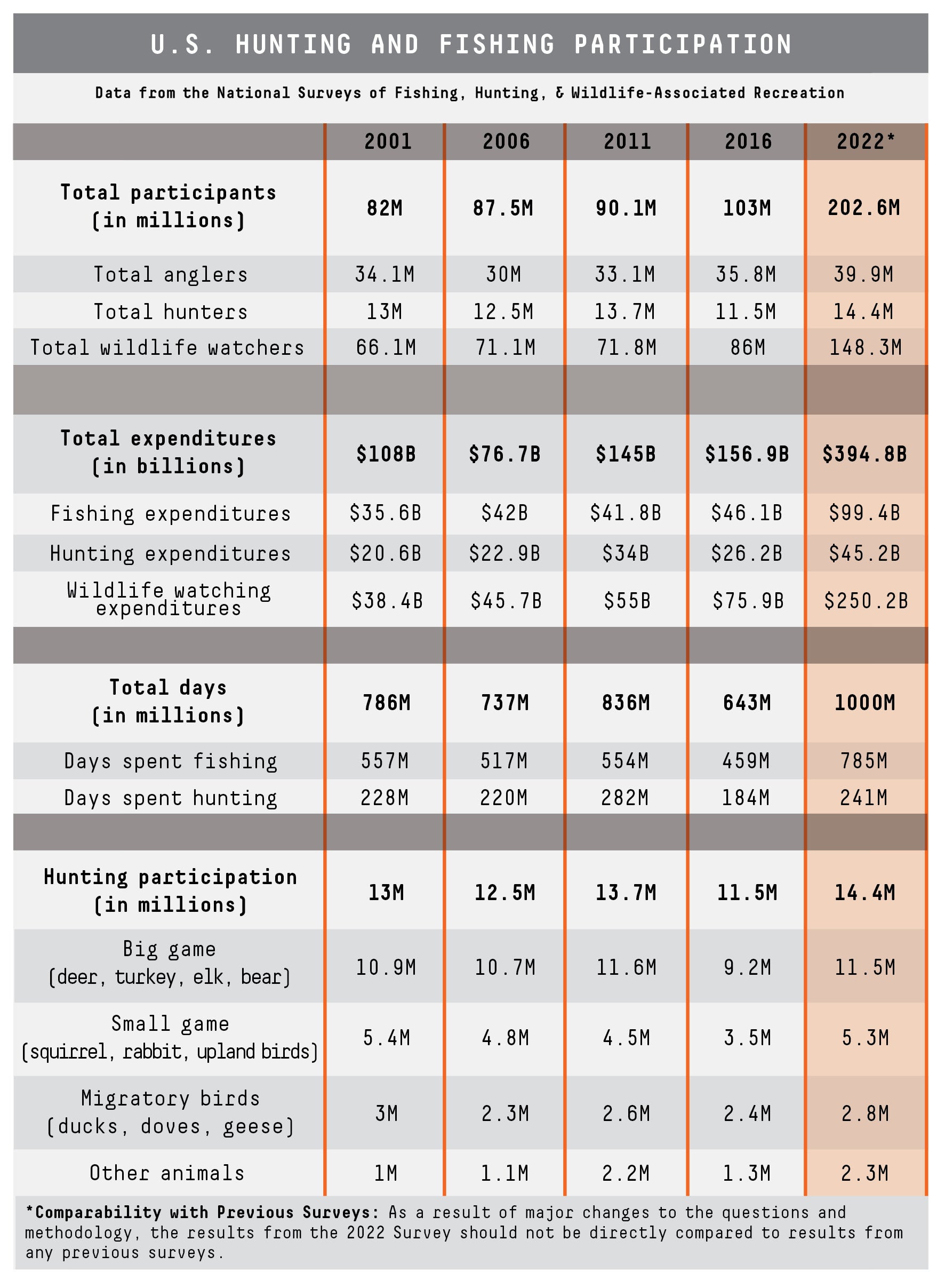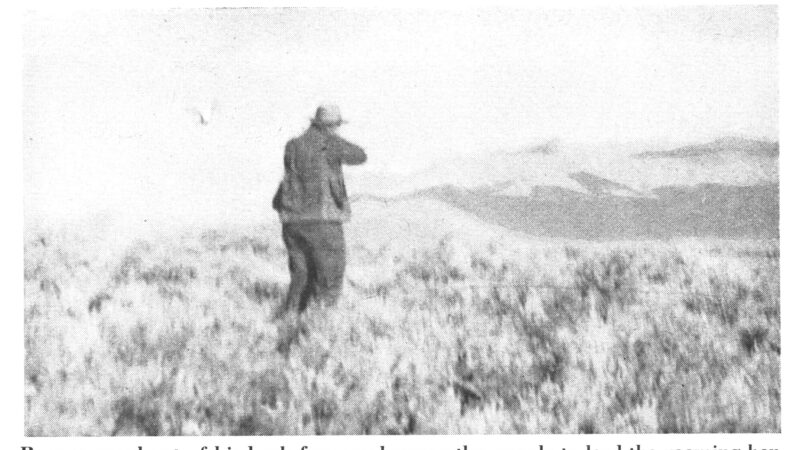National Survey Shows Millions of New Hunters and Anglers in the U.S.

A national survey of fishing, hunting, and outdoor-related recreation seems to confirm what you’ve probably noticed: there are more people than ever in your favorite hunting and fishing spots.
The survey, published (roughly) every five years by the U.S. Fish and Wildlife Survey, is a national snapshot of participation in outdoor recreation, as well as an accounting of the money we spend on fishing tackle, hunting gear, and all the other outdoor-related expenditures we try to hide from our spouse.
You can read the survey, which was conducted in 2022 (instead of 2021, due to the pandemic) and includes the input from over 105,000 respondents, as discouraging evidence of increased competition many established hunters and anglers have been reporting since the Covid-19 pandemic. But you can also read the results as good news, because they seem to suggest that our recruitment and retention efforts are resulting in more participation, which should lead to more advocates for hunting, fishing, and traditional wildlife management in ballot initiatives and elections.

The upshot of the 2022 National Survey of Fishing, Hunting, and Wildlife-Associated Recreation is that we probably have more hunters and anglers now than at any time in the past 30 years. This year’s survey pegged the total number of American hunters at 14.4 million, the highest it’s been since at least 1991. Angling participation is estimated at 39.9 million Americans, which is also the highest participation rate since at least 1991.
But the eye-opening statistic reported in the survey, which was published in the National Register yesterday, is a doubling in the number of wildlife watchers to 148.3 million people, or nearly half the American population. It should be noted that because of significant changes to survey methodology, it’s hard to make comparisons from this survey to those previous iterations. This year, for instance, surveyors added recreational shooters as well as youth between the ages of 5 and 16 to the results, which inflated many categories. In fact, USFWS goes to pains to note that “as a result of major changes to the questions and methodology, the results from the 2022 Survey should not be directly compared to results from any previous Surveys.”
The methodological changes undoubtedly make the 2022 edition the most statistically relevant survey to date, but because this USFWS effort is one of the few comprehensive snapshots of participation, expenditures, and recreational preferences that we have, comparisons to previous versions are inevitable. For instance, it was the 2016 survey, which showed a loss of two million American hunters—nearly 16 percent—that sparked the national R3 movement focused on recruiting new hunters, retaining existing hunters, and reactivating lapsed hunters.
Possibly owing to the changes in methodology, some of the data reported in the 2022 survey deviate widely from previous reports.
Consider the economic impact of hunting, fishing, and wildlife-related recreation. The record amount of money anglers and hunters spent on gear, nearly $400 billion in 2022 alone, is more than twice the previous estimation of $157 billion in 2016. To put that in comparison, receipts from U.S. corn and soybean production totaled $151 billion in 2022. Sales of firearms, ammunition, archery equipment, and fishing equipment have an amplified economic value, since taxes from those products are routed into accounts that are used for habitat and access improvements, shooting-range development, and fisheries and wildlife management.
“Wildlife recreationists’ avidity is reflected in the $394.8 billion they spent in 2022 on their activities,” the survey reports. “Of the total amount spent, $91.0 billion was trip-related, $179.0 billion was spent on equipment, and $124.9 billion was spent on other items such as licenses and land leasing and ownership.”
Further breaking down the receipts, anglers spent $99.4 billion on fishing, and hunters spent $45.2 billion on hunting. Wildlife watchers spent $250.2 billion on their wildlife-watching activities around the home and on trips away from home.
Read Next: We Actually Have No Idea How Many Hunters There Are in America
Americans spent $144.8 billion on fishing and hunting in 2022. Of that, $48.9 billion—34 percent—was for trip-related expenditures, including food, lodging, and transportation, while equipment expenditures amounted to $60.3 billion, 42 percent of the total. Other expenditures—magazines, membership dues, contributions, land leasing and ownership, and licenses, stamps, tags, and permits—accounted for $35.4 billion, or 24 percent of all expenditures.
Wildlife watching, which is defined as “closely observing, feeding, or photographing wildlife,” was enjoyed by 148.3 million people 16 years old and older in 2022. Of this group, 73.3 million people took trips away from home for the purpose of enjoying wildlife, while 146.5 million stayed within a mile of home to participate in wildlife-watching activities.
In 2022, wildlife watchers spent $250.2 billion. Trip-related expenses, including food, lodging, and transportation, totaled $42.1 billion, 17 percent of all expenditures. A total of $118.6 billion was spent on equipment, 47 percent of all wildlife-watching expenses. The remaining $89.5 billion—36 percent of the total—was spent on magazines, membership dues and contributions made to conservation or wildlife-related organizations, land leasing and owning, and plantings.
Hunting Participation in 2022
If the 2022 numbers are correct, then we have a record number of hunters in the field. The estimated 14.4 million hunters is a 25 percent increase over the 11.5 million reported in 2016, and nearly every segment of hunting saw an increase. The survey asks respondents to report their participation in four different categories of hunting: big game (which includes deer, turkey, bear, and elk), small game (squirrels, rabbits, and upland birds), migratory birds (geese, ducks, and doves), and other animals, which includes a menagerie of other legal species.
Specifically, 11.5 million Americans participated in big-game hunting in 2022, up from 9.2 million in 2016 and nearly on par with the 11.6 million big-game hunters in 2011. At 5.3 million, small-game hunting participation was close to the 11.6 million reported in 2011.
The 2.8 million migratory bird hunters in 2022 is the highest participation since 2001, when 3 million Americans hunted geese, ducks, and doves. And the catch-all category of “Other Animals” reported 2.3 million participants, the highest rate reported in the past 30 years.
Hunters reported spending an average of $837 on annual expenditures, and when in the field, spending $51 per day on average while hunting.
The five-year survey asks respondents to quantify the amount of time they spend in pursuit of their favorite quarry, and it seems the observed trend of hunters and anglers spending more time in the field is substantiated by the survey. In all, hunters and anglers collectively devoted one billion days to the fields and waters of America in 2022. That’s way up from the previous record of 836 million days in 2011. Americans spent 785 million days fishing and 241 million days hunting in 2022. Both are the highest intensity rates reported over the past 30 years, but again: It’s important to note that comparisons between previous surveys should be considered with skepticism.
Changes in Survey Methodology
So, why is the 2022 survey so aberrant? It’s largely because the latest iteration includes new categories of participants, including motorized boaters who don’t fish and recreational shooters who don’t hunt. It also includes younger participants in some categories, a demographic that wasn’t factored in previous reports.
“The Survey screen provides information about individuals ages 6–15 years old in 2021: 1.8 million hunted and 9.5 million fished. The number of 6-15-year-old wildlife watchers cannot be estimated due to a change in survey screening questions.”
If you remove those 1.8 million young hunters, then the 14.4 million hunters reported in the 2022 survey becomes 12.6 million, more in line with previous surveys. That’s still an overall increase in hunting participation since 2016.
The latest survey also quantified motorized boaters who don’t identify themselves as anglers. And surveyors added recreational shooters to the wildlife-watcher category, inflating that participation rate compared to previous surveys.
“The 2022 Survey is the first to include numbers of motorized boaters,” notes the surveyors in the report’s summary. “The number of target shooters who used a firearm and recreational archers were also estimated. The screening questionnaire asked of a household respondent for a year’s worth of activity, which means there is an unknown amount of overestimation in responses due to recall bias. With that caveat, an estimated total of 46.2 million people 6 years old and older went target shooting with firearms in 2021. Ten percent of them, 4.8 million, were children 6–15 years old, and the remaining 41.3 million were 16 years old and older. That means 16 percent of adult Americans went target shooting, either at a range or more informally in the field. As for archery, 18.8 million Americans 6 years old and older engaged in archery in 2021. Twenty-two percent of them, 4.2 million, were 6–15 years old. Seventy-eight percent, 14.7 million, were adults 16 years old and older, and their participation rate was 6 percent.”
It’s right to read the 2022 survey as a stand-alone snapshot of participation, and to resist the impulse to make comparisons to previous surveys. But there’s plenty of value to the latest report as a portrait of a community of hunters, anglers, and wildlife enthusiasts. The 2022 survey, for instance, includes granular data on the demographics of hunters, anglers, and wildlife watchers, including gender, age, race, regional distribution, and household income. You can read the full survey here.
The post National Survey Shows Millions of New Hunters and Anglers in the U.S. appeared first on Outdoor Life.
Articles may contain affiliate links which enable us to share in the revenue of any purchases made.
Source: https://www.outdoorlife.com/conservation/national-hunting-fishing-survey-results/




